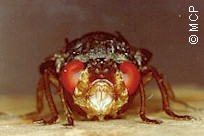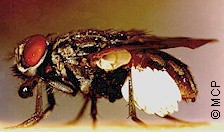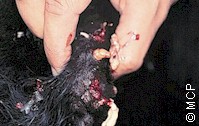Dermatobia hominis, the human bot fly, is a serious pest of livestock in tropical and subtropical regions of Central and South America (from the Mexican Gulf Coast down to tropical Argentina, but not in Chile). Not the adult flies, but the maggots are parasitic and cause so-called cutaneous furuncular myiasis. It is particularly harmful for cattle, but can infect also sheep, goats, horses, dogs, cats, other wild mammals and also humans.
They are very abundant in numerous regions and have various popular names: tórsalo, berne, boro, colmoyote, mayocuil, mirunta, nuche, tupe, ura, etc.

Human bot flies are obligate parasites, i.e. they cannot complete their life cycle without parasitizing their hosts. Within the myiases, nasal bot flies are primary myiases, i.e. they do not need a previous injury of the host to deposit their eggs on it.
The disease caused by Dermatobia hominis is called dermatobiasis.
Are animals infected with Dermatobia hominis contagious for humans?
- NO. The reason is that the maggots that infect a particular animal cannot be transmitted to other animals. The fly eggs that cause the disease in mammals are transmitted to other mammals through various vector insects. BUT: vector insects can lay eggs directly un human beings, where the eggs develop to maggots that can infect humans in the same way as animals. For additional information read the chapter on the life cycle below.
additional information in this site on the general biology of insects and/or parasitic flies.
Biology andlife cycle of human bot flies

Adult human bot flies are rather large, up to 1.5 cm long and look like bumblebees. They lack functional mouthparts.
flies and mosquitoes), which transport these eggs to a final host, mostly cattle but also other livestock, dogs, cats or even humans.
Larvae hatch about 5 days after being deposited, even still on the vector insect. They remain there until the vector visits a suited host. Once on a final host, Dermatobia larvae burrow into the skin of the host down to the subcutaneous tissue or use small injuries caused by biting insects. They do not migrate further in the host's body as other parasitic fly maggots do (e.g. warble flies). They continue development inside the host's subcutaneous tissue, while the host reacts surrounding the intruder in a capsule or foruncle that looks like a nodule on the skin of the host.
Maturing larvae feed on tissues and body fluids of the host. They keep an orifice open for breathing. They mature and grow inside the nodules during 5 to 7 weeks and can reach a considerable size, up to 2.5 cm long and ~1 cm thick. Mature larvae leave the nodule through the respiratory hole, drop down to the ground, burry themselves quickly about 2 cm deep in the soil, and pupate. Adults emerge from the pupae 5 to 8 weeks later.
Most soils are better suited for pupation and subsequent development of adult flies. Consequently fly populations peak usually after the rainy season. Adult flies do not feed at all, live only for about a week and their only task is reproduction. One adult female deposits a few hundred eggs during her lifetime. The life cycle is completed in 90 to 110 days.
Harm and economic loss caused by human bot flies

The nodules caused by the developing maggots are quite annoying and stressing for affected livestock. Undisturbed they do not become infected with secondary bacteria. But if the maggots inside are harmed (through rubbing, biting, etc.) they may produce quite nasty infections for the host.
Dermatobia hominis infections are usually not fatal for livestock. However, left untreated, weak or young animals massively infected can die. Economic damage can be substantial. Milk production of dairy cows can be reduced by up to 25%, and weight gains can be up to 15% lower in fattening cattle. Hides are irreparably damaged through the respiratory holes and are downgraded or even rejected. Torsalo is considered to be the major cause of hide damage in Central America.
Prevention and control of Dermatobia hominis
Best prevention of Dermatobia hominis infections in livestock and horses is to protect it against potential vectors such as flies (e.g. houseflies, horn flies, stable flies, horse flies), mosquitoes, and ticks. To this aim cattle, other livestock or horses are often treated with products that contain mostly organophosphates or synthetic pyrethroids, often in mixtures, and are available for spraying, dipping, or as ready-to-use pour-ons. Most such products are not directly effective against maggots in the skin of cattle, but will kill or repel potential vectors. A few such products (e.g. those that contain dichlorvos) are very effective for curing established infections. Rather shortly after administration the maggots actively leave the nodules, drop to the ground and die. All these products offer only a few days or weeks protection against re-infestation.
Most macrocyclic lactones (abamectin, doramectin, eprinomectin, ivermectin, moxidectin) administered as pour-ons or injectables to livestock are highly effective against established infections as well as preventatives. Length of protection is dose-dependent and can reach one to several months. However, only eprinomectin is allowed for use on dairy animals.
Dermatobia hominis can also affect dogs in endemic regions. Cats are usually less affected by this parasite. Best prevention for dogs is also to protect them against vector flies and mosquitoes. This can be achieved with modern spot-on (pipettes) and insecticide-impregnated collars. Insecticidal shampoos, soaps, aerosols, dusts and the like may protect dogs for a few hours or days, but not for weeks. The use of macrocyclic lactones (ivermectin, milbemycin oxime, moxidectin, selamectin) against Dermatobia infections in dogs is mostly not approved, and little information about efficacy in dogs is available. Whatever off-label use must be done only under supervision of a veterinary doctor, because these compounds can be toxic for dogs, particularly for collies and related dog breeds. If there are only a few maggots to be treated, petroleum jelly can be applied to the nodules. It will block the respiratory hole and the maggot inside will suffocate. About 24 hours later it can be squeezed out or removed with squeezers.
So far biological control of Dermatobia hominis (i.e. using its natural enemies) is not possible. Learn more about biological control of flies and other insects.
There are no true vaccines against Dermatobia hominis.
Click here if you are interested in medicinal plants for controlling flies and other external parasites of livestock and pets.
Resistance of Dermatobia hominis to insecticides or larvicides
In 2021 a first report on resistance of Dermatobia hominis to doramectin has been reported in a cattle farm in Brazil. It is a first warning and cross-resistance to other macrocyclic lactones must be assumed.
This means that if an antiparasitic fails to achieve the expected efficacy, it is likely that either the product was unsuited for the control of Dermatobia hominis or it was used incorrectly, but resistance cannot be excluded.
Learn more about parasite resistance and how it develops.
|
Ask your veterinary doctor! If available, follow more specific national or regional recommendations for Dermatobia control |